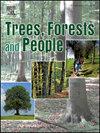气温和颗粒物2.5是亚热带常绿阔叶林大气负离子动态的关键环境驱动因素
IF 2.7
Q1 FORESTRY
引用次数: 0
摘要
空气负离子(NAIs)在评估森林对人类健康的治疗作用和通过中和空气中的颗粒物和通过氧化途径减少活性气体污染物等机制减轻空气污染方面的作用得到了广泛的研究。本研究考察了森林中NAI的时间动态和主要环境驱动因素。现场监测(2021年6月- 2023年5月)包括空气质量指数、空气温度、相对湿度、风速、直接辐射和颗粒物。研究发现,森林中NAI浓度基本符合世界卫生组织的清洁空气阈值,平均为1698±347离子·cm−3。NAI浓度呈单峰日分布,在12:00-15:00达到峰值,在5:00-8:00达到最低。NAI浓度的季节变化显著,夏季最高(1919±260离子·cm−3),秋季次之(1734±115离子·cm−3),春季次之(1580±338离子·cm−3),冬季次之(1535±226离子·cm−3)。相关分析表明,NAI浓度与气温、风速、直接辐射呈显著正相关,相对湿度与颗粒物呈显著负相关。多元回归和随机森林分析发现,气温和颗粒物2.5是影响NAI浓度的主要因素。建立了NAIs = 18.4 × Ta-17.5 × WS-3.6 × RH-8.0 × PM2.5 + 5.3 × PM10 + 1.8 × 103的预测模型。鉴于这些NAI的时间模式,研究结果支持在夏季和秋季下午安排森林治疗,以最大限度地暴露于峰值浓度的NAI。此外,该预测模型为森林地区的空气质量管理提供了实用工具,支持城市绿地规划、森林治理区规划和环境卫生政策制定的循证决策。这项研究解决了关于森林中NAI动态和环境驱动因素的关键知识缺口,可能为基于森林的健康干预和生态规划的循证决策提供信息。本文章由计算机程序翻译,如有差异,请以英文原文为准。
Air temperature and particulate matter 2.5 are key environmental drivers of negative air ion dynamics: Results from long-term monitoring in subtropical evergreen broad-leaved forest
Negative air ions (NAIs) are widely studied for their role in evaluating the therapeutic effects of forests on human health and mitigating air pollution through mechanisms such as neutralizing airborne particulate matter and reducing reactive gaseous pollutants via oxidative pathways. This study examined NAI temporal dynamics and key environmental drivers in forests. On-site monitoring (June 2021-May 2023) included NAIs, air temperature, relative humidity, wind speed, direct radiation, and particulate matter. We found that NAI concentrations in the forest generally met the World Health Organization's clean air threshold, averaging 1698 ± 347 ions·cm−3. NAI concentrations followed a single-peak diurnal pattern, peaking at 12:00–15:00 and reaching a minimum at 5:00–8:00. Seasonal variations in NAI concentrations were significant, with the highest levels in summer (1919 ± 260 ions·cm−3), followed by autumn (1734 ± 115 ions·cm−3), spring (1580 ± 338 ions·cm−3), and winter (1535 ± 226 ions·cm−3). Correlation analyses indicated significant positive correlations between NAI concentrations and air temperature, wind speed, and direct radiation, while relative humidity and particulate matter showed significant negative correlations. Multiple regression and random forest analyses identified air temperature and particulate matter 2.5 as the primary factors influencing NAI concentrations. A predictive model (NAIs = 18.4 × Ta–17.5 × WS–3.6 × RH–8.0 × PM2.5 + 5.3 × PM10 + 1.8 × 103) was developed to estimate NAI concentrations in forest environments. Given these temporal patterns of NAI, the findings support scheduling forest therapy in summer and autumn afternoons to maximize exposure to NAI at peak concentrations. Additionally, the predictive model offers a practical tool for air quality management in forested areas, supporting evidence-based decisions in urban green space planning, forest therapy zone scheduling, and environmental health policy development. This study addresses a crucial knowledge gap regarding NAI dynamics and environmental drivers in forests, potentially informing evidence-based decision-making in forest-based health interventions and ecological planning.
求助全文
通过发布文献求助,成功后即可免费获取论文全文。
去求助
来源期刊

Trees, Forests and People
Economics, Econometrics and Finance-Economics, Econometrics and Finance (miscellaneous)
CiteScore
4.30
自引率
7.40%
发文量
172
审稿时长
56 days
 求助内容:
求助内容: 应助结果提醒方式:
应助结果提醒方式:


